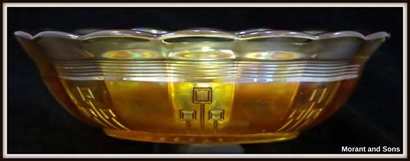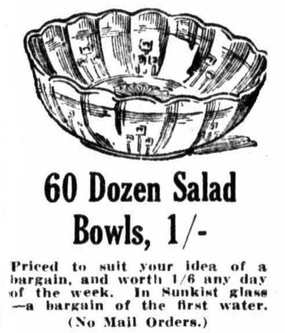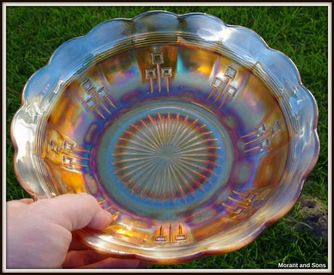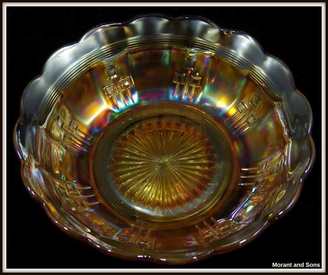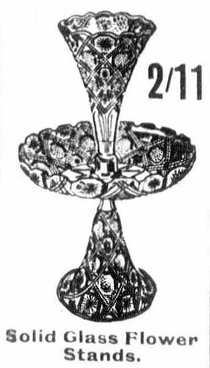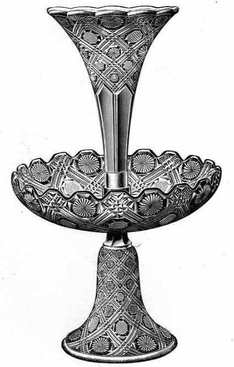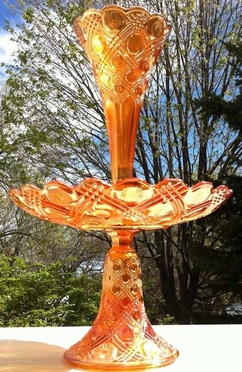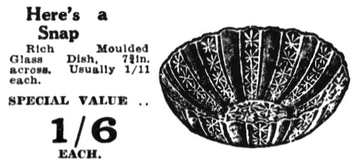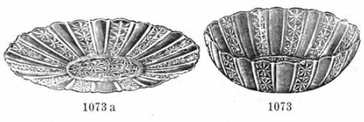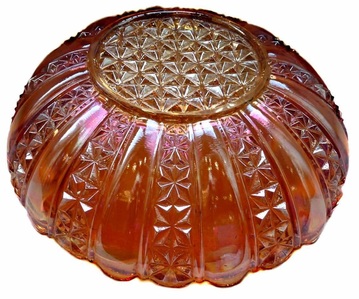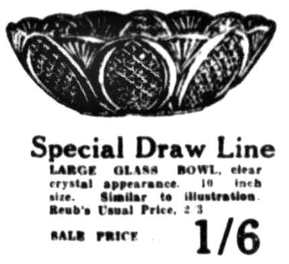Reub Levy – The King of China - Part Two
|
Reub Levy – the King of China – didn’t just sell glass from the USA, he also advertised and sold some rare and amazing pieces of European and Australian glass too. Here we share with you some extracts from Levy’s ads that featured these items. Let’s start with an unexpected delight – the very first newspaper ad we have seen for a rather hard-to-find Crown Crystal pattern known as Pin Ups. |
|
Pin Ups – Crown Crystal, Australia
Reub Levy had 60 dozen of them! (That means 720 if you’re not familiar with a “dozen”). See how these bowls were described as being in Sunkist glass, which was one of Levy’s promotional terms for marigold Carnival. In fact Crown Crystal described their Carnival as “Iridescent Ware” (which was probably marigold) and “De Lustre Ware” (which was probably their purple Carnival) – and later collectors referred to these respectively as “marigold” and “dark”. But here we have Reub Levy using his own term – Sunkist – and adding a phrase we are not familiar with “a bargain of the first water”. It's interesting to see "No Mail Orders" at the foot of the ad - clearly Reub wanted to use the specially priced offer to entice buyers into the store, where he hoped they would buy more goodies! |
|
It’s a splendid ad for a delightful piece of Carnival – the pattern is generally referred to as Pin Ups today, but the name Hatpins may also be used. Known in marigold and “dark” (purple) the Pin Ups bowls can be found in 7.5 inch and 9 to 10 inch bowls. There is also a rare diminutive bowl (around 3 inches). Pin Ups can be tightly ruffled or simply scalloped, and the edge may be cupped in a little or flared out. |
Above: a stunning 9 inch marigold Pin Ups bowl, shown courtesy and copyright Brendan Morant
European Glass
Not all Levy’s offerings were specified as being made in iridescent (Sunkist, etc) Carnival, but as the following patterns (and shapes) are all known in Carnival, it’s entirely possible that Reub was selling them in iridescent glass too.
Tartan epergne – Brockwitz, Germany
Described in Levy’s ad as being a “Handsome, useful ornament, standing 15 inches high”, this magnificent item was sold for 2/11d in 1914 (the price went up by a third the following year). No mention is made of the item being sold in iridescent glass, but we know that the Tartan epergne has indeed been found in Australia in marigold, so it seems likely that Carnival versions were indeed imported into Australia from Brockwitz in Germany.
Tartan epergne – Brockwitz, Germany
Described in Levy’s ad as being a “Handsome, useful ornament, standing 15 inches high”, this magnificent item was sold for 2/11d in 1914 (the price went up by a third the following year). No mention is made of the item being sold in iridescent glass, but we know that the Tartan epergne has indeed been found in Australia in marigold, so it seems likely that Carnival versions were indeed imported into Australia from Brockwitz in Germany.
Above left: a 1914 ad from “The King of China” that featured a Brockwitz Tartan epergne.
Centre: extract from Brockwitz’ 1915 catalogue showing the Tartan epergne. Brockwitz called this pattern Kopenhagen.
Right: a magnificent marigold Tartan epergne, shown here courtesy of Michael O’Brien.
Centre: extract from Brockwitz’ 1915 catalogue showing the Tartan epergne. Brockwitz called this pattern Kopenhagen.
Right: a magnificent marigold Tartan epergne, shown here courtesy of Michael O’Brien.
Cane Panels – Rindskopf, Czechoslovakia
“Here’s a snap”! Reub Levy offers a Rindskopf Cane Panels (also known as Panelled Cane) bowl. The bowl shape is rare in Carnival and is only known in marigold. In fact the first reported bowl was written about in our NetworK ezine #6, in 2015 (thanks to Janet and Graham Dickson).
We don’t know if this was offered by Levy in iridescent glass, but it’s entirely possible.
|
Read more about Cane Panels in our Collectors Facts.
Diamond Ovals – Rindskopf, Czechoslovakia This is a familiar pattern that was first illustrated in Rindskopf’s catalogues in 1915. On the right we have a 1928 ad from Reub Levy featuring a bowl in this pattern as a “Special Draw Line”. Although this wasn’t offered in Carnival, it’s still interesting to see it and to recognise that it was imported into Australia from Czechoslovakia. On the right: A 1928 ad from “The King of China” features a Rindskopf Diamond Ovals bowl. Below, left: extract from Rindskopf’s catalogue, showing the pattern collectors now call Diamond Ovals. Below, right: a splendid marigold Diamond Ovals bowl shown courtesy Michael O’Brien |

